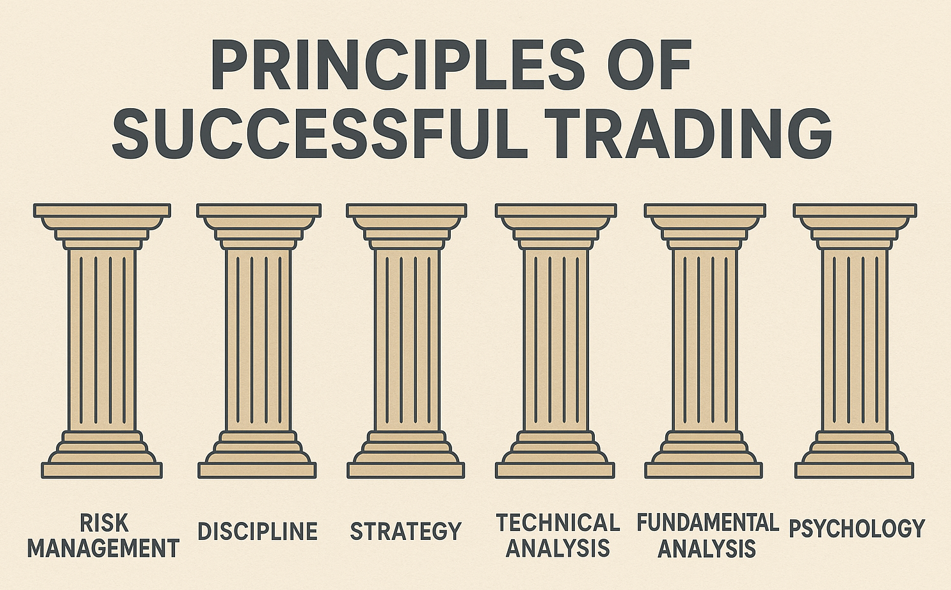Principles of Successful Trading
In an age dominated by machine learning, high-frequency trading (HFT), AI, and complex black box models, it’s easy to believe that only the most sophisticated strategies have any edge left. But it’s not!
If simple can succeed, why complicate things? (Though simplicity does not mean it’s ‘easy,’ as nothing worthwhile is).
Many trading rules stand the test of time not because markets are static, but because they are built on the timeless principles of human behaviour, risk, and trend. These might be called “universal principles,” and they form the scaffolding behind every robust trading approach. The real magic is not in finding a perfect formula, but in building a disciplined process around a handful of simple, durable ideas that generate robustness.
Related reading: Habits of Rich, Wealthy, and Successful Traders
Let’s explore the six principles of how you can start trading:
Principle One: Preparation – Build Your Foundation Before You Trade
Just as a building relies on its foundations, trading relies on preparation. Preparation means designing your rules for survival before you ever place a trade.
You must expect “maximum adversity and randomness”. Your goal isn’t to avoid losses, but to become the “best loser” in the room: the one who takes small, controlled losses and lives to fight another day.
We urge traders to set boundaries upfront, including:
- A maximum amount they are willing to lose over their career.
- A risk management framework (covering capital at risk and position sizing).
- A partner or accountability mechanism to enforce discipline.
That last point, accountability, is wisdom that traders often overlook. Also, two traders think better than one trader. Even better is a mentor!
Principle Two: Survival – Make Sure You Have Positive Expectancy
The second principle centers on perspective. Successful trading means realizing that survival is the first goal, not riches. You must drive the risk of ruin down to negligible levels; be a blue-collar trader.
Once survival is locked in, you need to understand expectancy. Expectancy is the simple math that describes your edge:
Expectancy=(Average Win×Win Rate)–(Average Loss×Loss Rate)
While a positive expectancy is merely a statistic pulled from a backtest, clear thinking about position sizing combined with hoped-for expectancy will provide a good idea of your risk of ruin. The aim is a 0% chance of ruin.
Strategies dating back nearly a century, such as and Donchian’s Four-Week Rule (1960), still generate profits across diverse markets when applied with discipline. They are powerful due to their robustness, not their elegance. This robustness builds belief, and deep conviction is crucial to stop you from abandoning your system during an inevitable drawdown.
The hierarchy is clear: Survival, then expectancy.
Principle Three: Trading Style
After securing survival and building conviction, the next step is choosing your style. Trading is a business, and you must do “what works”. You need to understand the attributes of the model you are building to set the right expectations and judge its performance accurately.
For instance, trend following strategies have different rules, performance times, needs, and risks compared to mean reversion strategies. Your approach to backtesting and risk avoidance will differ significantly depending on the style chosen.
Principle Four: Trade Where the Risk is Lowest
The best markets share critical traits:
• Liquidity.
• Transparency and fair regulation.
• Low transaction costs.
• The ability to short easily.
We belive the best place to start is in the stock market. Single stocks offer the least effiecient markets, in our opinion. You can also develop many differetn types of trading strategies.
Index futures and currency futures are also examples that tick most of these boxes.
The true insight here, however, is portfolio thinking. Portfolio diversification is putting simplicity into profits.
Principle Five: Money, Method, Mind
This principle forms the heartbeat of a successful trading framework:
1. Methodology comes first: Your system is important: You need to make sure you have a positive expectancy. Without positive expectancy, you cannot win. It will make or break you.
2. Money management comes second: Without capital, you cannot play. Fixed-fractional risk rules (e.g., risking 0.25–0.5% of equity per trade) saves you from ruin. Strategy diversification comes into play.
3. Psychology comes third: Fear, hope, greed, and pain must be managed not through willpower. You must beat your brain before you can beat the markets!
Principle Six: Execute, Then Get Out of the Way (Automation Is Power)
The final act of trading should be mechanical and ritualistic. Execution is not the time for improvisation or creativity. Even better is if you can automate. Automation is power because you can trade many strategies. Automation is perfect for diversification. Diversification is the only free lunch.
By the time a signal appears, all the heavy lifting – in preparation, system design, and risk management – is already done. Trading, paradoxically, is the least glamorous part of the process; it is simply pressing the button and moving on.
Five Key Takeaways for Traders
1. Simple still works. Do not dismiss an old breakout rule because it appears primitive; simplicity often correlates with robustness.
2. Portfolio thinking matters. A lot happens at the portfolio level, involving capital allocation rules, risk changes, and real diversification.
3. Diversify by method as well as market. Blend markets, models, and time-frames to reduce correlation.
4. Robustness beats cleverness. Use multi-market testing as a true robustness-test.
5. Principles don’t age. Good process, risk management, disciplined execution, and right expectations probably matter more than any indicator.

